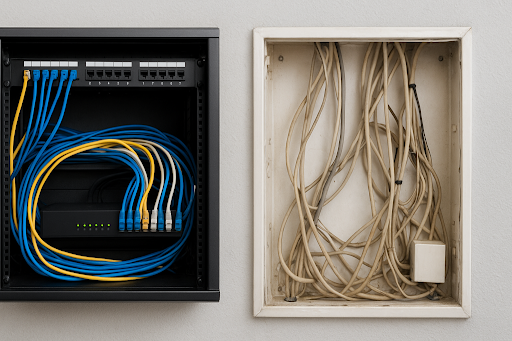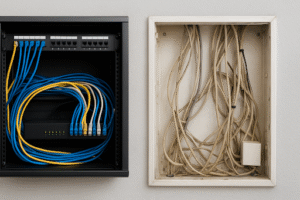As McKinney continues to grow, with new offices, businesses, and workspaces opening every month, companies are investing more in fast, reliable, and future-ready connectivity. Whether it’s installing security cameras, smart devices, or powering your phones and internet, your cabling plays a crucial role in the seamless execution of work and your business’s progress.
For many business owners, the question comes down to one comparison: which is preferable for businesses, traditional cabling or structured cabling?
Moreover, below is a simple, clear breakdown to help you decide what’s suitable for McKinney-based businesses, especially if you are looking for fast, organized solutions ready for future expansion.
What is Traditional Cabling?
Traditional cabling uses outdated, basic wiring methods, connecting each device individually with separate wires for security cameras, phones, internet, access control, and other systems.
Where traditional cabling works?
It is mostly found in;
- Old buildings
- Small offices
- Businesses with limited expansion plans
- Workplaces with minimal tech needs
No doubt, traditional cabling is enough for small businesses, but businesses in McKinney are expanding and adopting cloud systems, VoIP phones, video surveillance and smart buildings. The key drawback of traditional cabling is that it quickly falls short.
What is Structured Cabling?
Structured cabling is an advanced, organized and scalable wiring method. It utilizes a standardized system that consolidates all communication and data cables into one organized and well-designed infrastructure. Furthermore, everything is routed through patch panels, racks, and an organized cable pathway, making it easier and neater to manage.
Where structured cabling works?
It’s perfect for;
- Modern offices
- Businesses with great expansion plans
- Medical and dental clinics
- Tech-heavy companies
- Industrial facilities and warehouses
- Retail stores with POS+security

Structured Cabling Vs. Traditional: Key Comparison
| Traditional Cabling | Structured Cabling | |
| Speed & Performance | Designed for a basic communication system. It slows down when multiple devices are connected, especially during peak working hours or high traffic. | Built for optimal speed. From cloud services to multiple data streams, modern networking and data transfer, structured cabling supports everything at once. |
| Scalability (Future Growth) | When you expand your business, hire new employees, add new systems, or shift to digital operations, you need new wiring for everything. It is not only time-consuming but also expensive. | It’s expansion-ready, so you can easily add more devices and equipment without tearing down walls or laying additional cables. Ideal for businesses planning to expand in McKinney’s booming economy |
| Organization & Cleanliness | Expect tangled wires and scattered connections. So downtime increases, and troubleshooting becomes a challenge. | They are organized, neat and well-labelled. Everything routes back to a single organized location (like a server room and closet). Technicians can easily identify and fix issues, reducing service time and keeping your business running smoothly. |
| Realiability & Downtime | They are unreliable and cause cable confusion and loose connections. Besides, outdated wiring may cause slow internet, dropped calls and sudden outages. | They are stable. With fewer points of failure and high-quality connections, structured cabling ensures a consistent and predictable network. It’s a great perk for McKinney’s busy office, as fewer interruptions mean higher productivity. |
| Cost Over Time | Cheaper upfront, but the cost increases every time you add new devices or upgrade technology. It also requires frequent maintenance and high maintenance costs. | The initial setup cost is slightly higher, but the long-term benefits are undeniable. You invest once, and the system continues supporting new tech for years without significant changes. |
Why Structured Cabling is a Preferred Choice for Most McKinney Businesses?
McKinney’s commercial space is moving fast. Businesses are using more cloud applications, data, and automation. Traditional cabling isn’t suitable for this level of connectivity.
Here’s what structured cabling offers;
- Easier Management
- Faster Troubleshooting
- Better support for advanced technology
- Higher bandwidth
- Flexibility with business expansion
- Smooth performance during peak usage
Whether you are starting a new office or upgrading an old building, a structured cabling system provides a solid foundation for your business.
Bottom Line: Which One to Choose?
If your business relies on stable internet, multiple connected devices, cloud-based software, CCTV or access control, VoIP phones, or a growing staff. In that case, then structured cabling is a smarter choice and a great investment with long-term benefits.
Traditional cabling may work only if you are running a small setup with minimal tech. However, for most McKinney companies in 2025, structured cabling ensures reliability, improved performance, and better organization.





